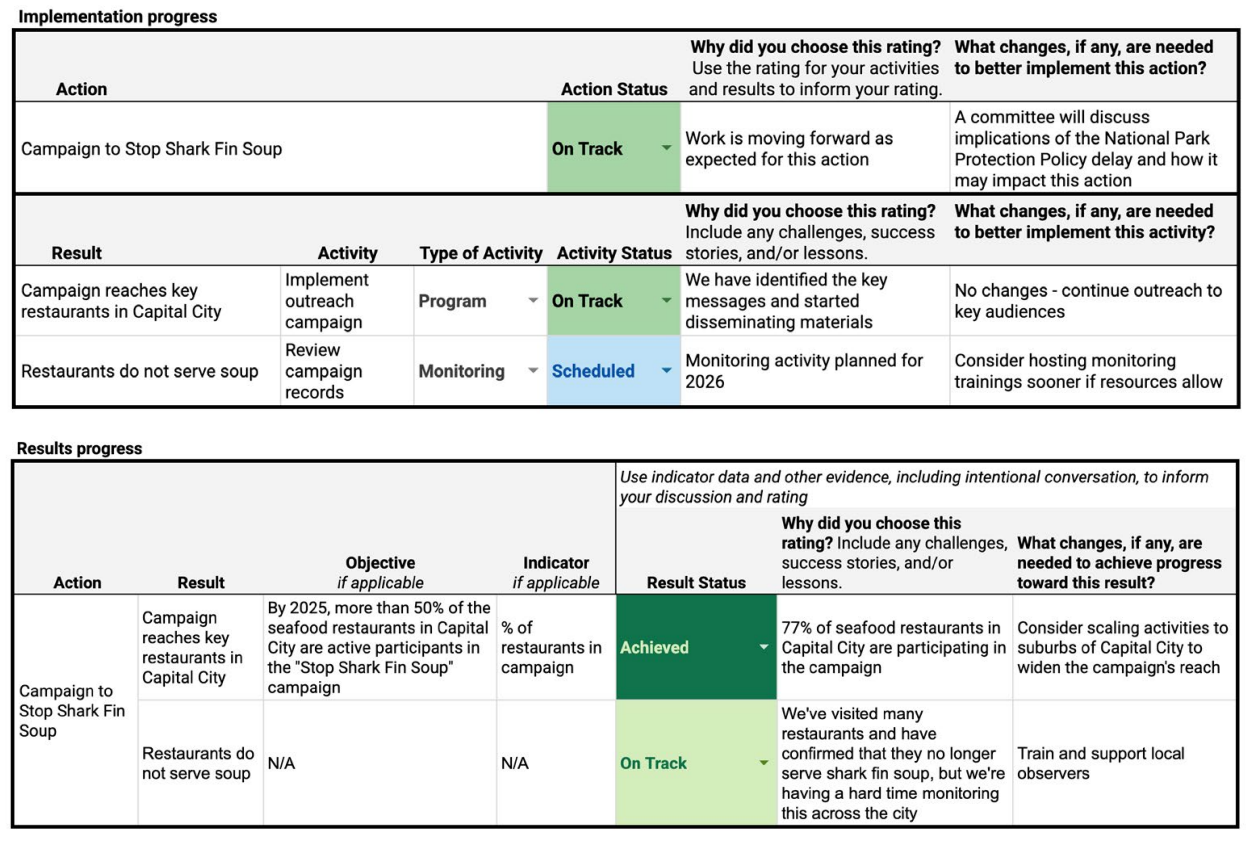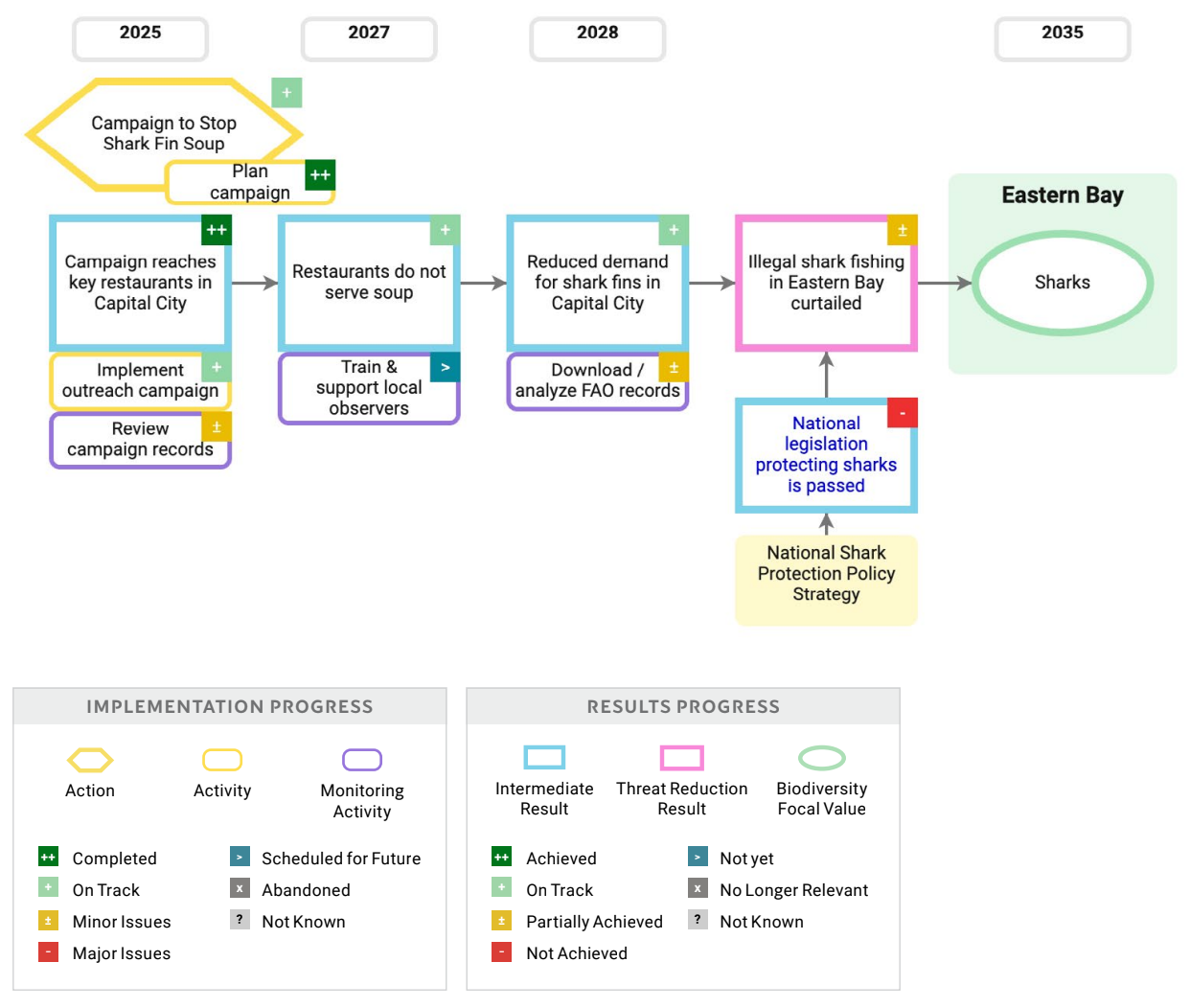This step of the Conservation Standards involves managing data as they come in and regularly analyzing them to convert them into useful information and knowledge. In particular, you need to analyze your project’s results, core assumptions, key uncertainties, feedback from interested parties, any grievances raised, and relevant operational and financial data, and then adapt your work plan as necessary. The monitoring system you set up in Step 2 (Plan) will support you in your analyses. If your team is entering the Conservation Standards cycle at the Analyze & Adapt Step, the data and lessons you gather can inform your work going forward, overlapping with or feeding directly into other steps in the cycle.
The depth of analysis at this stage can range from very simple and fast to time intensive and complex. As with the selection of monitoring methods, you should make sure that the depth of your analysis matches the level of evidence required by your situation and your audiences’ information needs. Moreover, as with all steps in the Conservation Standards, it’s important to foster a learning environment to ensure teams are comfortable reflecting and recognizing failures, in addition to successes.
4A. Prepare Your Data for Analysis¶
Analysis is a process of transforming raw data into information that can inform decisions. Analysis should not happen at only one point in the life of the project. To continuously understand what is happening with your project and to be able to change things in a timely fashion, it is essential to capture and analyze your monitoring data as part of routine project work, using the data management systems that you put in place in Step 3.
Preparing your data for analysis is really a continuum between Steps 3 and 4. Your team should regularly record, store, process, and back up all your data, including programmatic, operational, and financial data. This work will be much easier if you systematically check, clean, and code your raw data as you collect them and keep an organized account of their associated metadata. It may also be useful to create a system that includes a centralized repository and to provide clear guidance on where and how to find data. In general, it is good to understand how your organization and partners are storing and managing data and to use compatible software and a unified data schema. This is especially important in the case of joint monitoring, evaluation, and learning. Getting these systems in place early in your project will make ongoing data collection and analysis more efficient.
Ideally, your systems should manage and present your data to easily meet the key information needs laid out in your strategic plan. As you move to Step 4B, consider how to visualize your data so that all interested parties can interpret the information to make adaptive management decisions. If relevant, you can use specialized software to collect, process, analyze, and visualize your data and develop integrated reports and dashboards.
4A OUTPUTS
- Key project data recorded, stored, processed, and backed up on a routine basis
- Visualizations of key data for decision making
4B. Analyze and Reflect on Results¶
An important aspect of good conservation practice is regularly and systematically assessing whether your team is implementing the high priority work identified in your strategic plan and if you are on track to achieve your stated goals and objectives. This information, compiled through your monitoring data and other sources, provides the foundation for making appropriate adaptive management decisions to keep you on track.
Your monitoring data should help you fill knowledge gaps, review progress on implementation, determine whether you have achieved your expected intermediate results, assess whether you are on track to achieve long term success, and document any significant unintended consequences of your work. In addition to your monitoring data, your team should consider other available information, including project evaluations, recent external analyses, and perspectives from interested parties. Analyzing your monitoring data and other information sources can help you determine whether the core assumptions you laid out in the planning steps (especially in your situation analysis and theories of change) hold true in reality. This knowledge can help your team understand why certain actions have succeeded or failed. By testing and reflecting on your core assumptions, you are in a better position to adapt your project accordingly. You also gain knowledge and experience that can contribute to a broader evidence base to help inform other conservation efforts.
To ensure your team is using your plan and monitoring data to learn and adapt, you should regularly review and reflect on your project. Some teams refer to the analysis as a pause and - reflect or reflect-and-adapt process. These exercises may occur at different times (e.g., quarterly, every six months, annually), in different settings (e.g., formal workshop, intentional conversations with a small group), and at different scales (e.g., project, program, portfolio). You may also hold these discussions in response to third-party evaluations or audits . Your team might find social science tools and approaches helpful to analyze the psychological, social, and behavioral parts of your theory of change.
Consider these guiding questions in your analysis:
- Has the context changed? If so, how does it impact your team’s work?
- Did your team do what you set out to do? If not, why not?
- Are you achieving what you expected to achieve? Why or why not?
- Has your team seen changes in human behavior, beliefs, attitudes, or intentions? Are these a result of your work or changes in the context?
- Are there unexpected negative results derived from your work? - Are there additional information needs, uncertainties, or risks your team needs to consider?
- What decisions do you need to make based on this analysis?
There are many ways to facilitate and document your analysis. Figure 1 provides an extract of table formats that track progress towards implementation and results and allow easy documentation of changes needed or decisions made. Figure 2 is an example of a results chain with implementation and results tracking. The details of progress can be found in the progress notes, as demonstrated for the monitoring action SHARK M1. Review campaign records.

Figure 1:Example Tables with Implementation and Results Progress.

Figure 2:Example Results Chain-Based Theory of Change with Implementation and Results Progress.
In addition to programmatic analyses, it is also important to consider whether the operational processes supporting your project are functioning properly. You may have a project that uses the perfect actions to address the threats and opportunities affecting your focal values, but your team may not be operating as efficiently as possible or does not have the administrative or financial support it needs to do its job well. To improve your understanding of what is truly happening, collaboration among all members of your team in these analyses is vital. Your operational analysis might explore the extent to which you have
- Sufficient resources (e.g., financial, human, administrative, political) to carry out your project;
- The right skills among your team members to implement your project well;
- The physical infrastructure and equipment (e.g., office space, vehicles, computers) you need to do your job;
- Functioning social safeguards in place; and/ or
- Your project team operates smoothly and equitably (e.g., communications, delegation of responsibilities).
For learning and effective communication, it is important to involve the right people in the analyses and/or to share preliminary analyses with them. As a general rule, analyses should involve members of the project team, as they will have the deepest understanding of the project and overall situation. Depending on the context and where appropriate, team members may be conducting the analyses themselves, or they could help review and interpret analyses. However, teams should take care not to influence the findings unjustifiably. While team involvement is important, input from interested parties, outside experts, or those with other perspectives is also valuable and can help provide a balanced interpretation of monitoring results.
4B OUTPUTS
- Analyses of project results and assumptions
- Analyses of operational and financial data
- Record of discussions and decisions
4C. Adapt Your Plans and Budgets¶
Collecting and analyzing data as part of routine monitoring activities allow you to determine how effective your interventions are and what adjustments are needed to reach your goals and objectives more efficiently. As the final part of this step, you should use what you learned during the analyses and discussions to modify (as needed) and optimize your portfolio of strategies and to periodically realign the allocation of resources (people and funds). This is the essence of good conservation practice and adaptive management.
All the planning that you did earlier was not meant to be a one-time event, never to be revisited or used again. Instead, in order to learn and improve your work over time, your team should revisit and make needed adjustments to your strategic plan (including situation model and theories of change), monitoring plan, operational plan, work plan, and budget. Learning and ideas for improvement may come from internal discussions with your team, findings from formal evaluations or audits, feedback from interested parties familiar with your work, and/ or research findings relevant to your context. In some cases, plans might be “officially” updated every 5-10 years. However, it is good conservation practice to make interim adaptations, as appropriate, every 6 12 months and then incorporate these changes officially at the appropriate time.
As you make changes, you should document the rationale and/or evidence behind these decisions so that others will understand what you learned and why you made these changes. Documentation is an important input to Step 5 (Share). There are many ways to document your adaptations including narratives, change logs, and updates to diagrams. Whatever approach you choose, be sure that it’s agile enough to support you in adapting your project efficiently.
However, also take note that making adaptations may not be as simple as analyzing and reflecting on data and identifying and documenting decisions. It is important to understand what enables adaptation in your context and how feasible it is to make your proposed changes. Be sure to consider at what scale changes need to be made, who will be responsible for pursuing these changes, and, if relevant, which messages and evidence key audiences will need to approve changes. Finally, keep in mind that you may learn that some of what you are doing is working well and no adjustments are needed. The important thing is to leave time for reflection and analysis so that you can understand where you do need to adapt.
4C OUTPUTS
- Revised project documents, such as your strategic plan (including situation model and theories of change), monitoring plan, operational plan, work plan, and budget
- Documentation of evidence, discussions, lessons learned, potential risks or uncertainties, and decisions
ANALYZE & ADAPT RESOURCES
CS Library Resources: Filter by “Analyze & Adapt” and then search within, if desired, by guidance, case studies, or other search terms
Recipes for Conservation: A Conservation Standards Toolkit: Navigate to the relevant Tipsheets in the Recipe Toolkit, as well as the Analyze & Adapt sections in the Examples & Resources document
Real-world Examples of Applications of the Conservation Standards